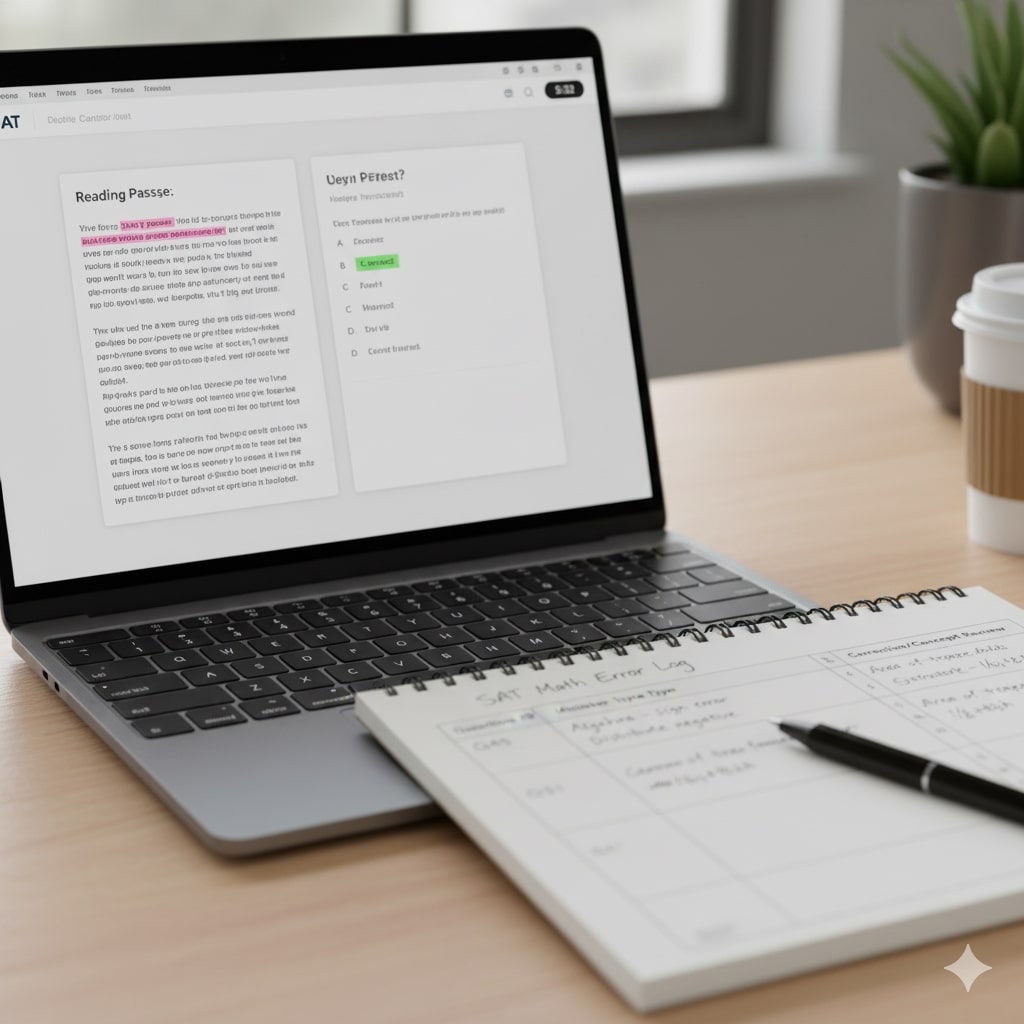Introduction: You Can Intern and Prep for the Digital SAT — Without Losing Your Mind
Juggling an internship and SAT prep feels like patting your head while hopping on one foot — possible, but awkward without a little practice. The good news: many students before you have walked this tightrope and come out stronger, with clearer career direction and a competitive SAT score. This blog is written for the busy intern who still wants to do well on the Digital SAT. Think of it as a friendly coach that gives you the strategies, templates, and mindset to make steady progress without trading sleep for stressed studying.
Why Internships and SAT Prep Can Actually Complement Each Other
It’s tempting to view the internship and SAT as competing priorities. But they can be synergistic. Internships develop skills—reading technical documents, managing deadlines, solving problems under time pressure—that translate directly to SAT success. With the right approach, your internship becomes a source of focused practice rather than a distraction.
- Critical reading in the workplace strengthens your evidence-based reading skills — notes, emails, and reports are practice in disguise.
- Real-world problem solving mirrors math reasoning — interpreting data, estimating answers, and choosing efficient methods are the same mental muscles.
- Time-management during an internship is transferable — building a study routine around work hours makes consistency realistic.

Begin with Reality: Audit Your Schedule and Energy
Before you build a plan, know the raw facts: how many hours does your internship actually take each week, what are peak busy periods (e.g., project deadlines), and when are you most alert? A 10-minute audit for one week will save hours later.
- Track calendar commitments (meetings, commute, deliverables).
- Note your energy windows: are you a morning person or an evening studier?
- Record unavoidable commitments like classes or study groups.
Pro tip: Reserve a short weekly planning session (10–15 minutes) every Sunday to reconcile work deadlines and study targets for the coming week.
Set a SMART Goal: Not Just “I’ll Study More”
SMART goals (Specific, Measurable, Achievable, Relevant, Time‑bound) keep you honest. Instead of “study more,” try: “Increase my Math section score by 50 points in 8 weeks by completing two targeted practice sets per week and one full digital practice test every two weeks.”
- Specific: which section and how much improvement?
- Measurable: number of practice tests or hours per week.
- Achievable: factor in internship hours and rest.
- Relevant: align with college goals (scholarship thresholds, program requirements).
- Time-bound: pick a test date or checkpoints.
Design a Flexible Weekly Study Plan
Your study plan should respect the variability of internships. Use a “core + buffer” approach: core study blocks that are non-negotiable and buffer blocks that you can shift during crunch weeks.
Sample Weekly Template (for interns with ~15–25 internship hours/week)
| Day | Core Study (fixed) | Buffer / Optional |
|---|---|---|
| Monday | 30 min: Math skill work (targeted practice) | 20 min: Review missed problems |
| Tuesday | 40 min: Reading & Writing passage practice | 10 min: Vocabulary/grammar micro drills |
| Wednesday | 30 min: Practice problem set (mixed) | 20 min: Strategy review (timing, annotations) |
| Thursday | 40 min: Full section simulation (timed) | 15 min: Error log update |
| Friday | 30 min: Targeted math or essay practice | 20 min: Light review / flashcards |
| Saturday | 1–2 hours: Full digital practice test (every 2 weeks) | 1 hour: Deep review of test mistakes |
| Sunday | 15 min: Plan the week and reflect on progress | Rest or catch-up |
Two rules: (1) Keep sessions short and consistent — frequent, focused practice beats marathon cramming. (2) Protect at least one day or evening as a rest window to avoid burnout.
High-Impact Study Activities for Limited Time
When you’re short on time, pick activities with the highest return on investment. Here are study elements that deliver the most gains per minute.
- Targeted mistake review — analyze why you missed each question and write a short note about the misconception. That reflection is where durable learning happens.
- Adaptive practice — use official digital practice tests (Bluebook-style) or the Student Question Bank to focus on weak areas rather than repeating what you know.
- Timed sections — practicing under time helps build pacing; do at least one timed section per week.
- Active reading habits — annotate short passages, summarize paragraphs in the margin, and predict next-sentence ideas to improve comprehension speed.
- Mental math and calculator strategy — refine when to use the calculator and when to do quick algebraic shortcuts.
Make Practice Tests Work for You
Practice tests are the single most useful tool — but only if you use them smartly. Turn each test into a data source about your pacing, error patterns, and content gaps.
- Simulate test conditions: device setup, environment, and breaks matter for the Digital SAT.
- After the test, spend twice the time you took to complete it reviewing mistakes.
- Log errors by type (careless mistake, concept gap, timing) and by question format (command of evidence, algebra, geometry, punctuation).

Quick Wins for the Digital Test Format
The Digital SAT has its own mechanics. Small adjustments in practice can yield big benefits on test day.
- Familiarize yourself with the Bluebook testing app and device requirements early to avoid technical surprises.
- Practice with a tablet or laptop similar to your test device so screen layout and navigation feel natural.
- Use the test tools (highlighting, answer flagging) in practice to find a test-taking flow that suits you.
- Adapt to item-adaptive testing by focusing on accuracy and consistency: a string of correct answers changes question difficulty, so steady performance matters.
How to Study Around Internship Crunch Weeks
Some internship weeks will be intense. The goal is to reduce the damage to your study rhythm without expecting perfection. Use these strategies when work ramps up.
- Switch to micro-study — replace a 40-minute block with three 12-minute sessions across different days.
- Focus on review over new learning — reviewing past mistakes preserves progress more than struggling to learn brand-new concepts under fatigue.
- Leverage passive study — listen to short strategy podcasts, watch quick technique videos, or read a 1-page grammar rule during commutes.
- Communicate — if your internship mentor expects 40+ hours but that’s unsustainable with your goals, discuss adjusting tasks or hours temporarily; many supervisors appreciate honesty and focus.
When to Get Help: Tutoring, Mentors, and Sparkl’s Personalized Approach
Knowing when to seek help is a mark of strategic studiers, not weakness. If you’re plateauing or your schedule is chaotic, a personalized tutor can turn a few hours of high-quality instruction into weeks of saved effort.
Sparkl’s personalized tutoring model offers several benefits that fit naturally into internship schedules: short, focused 1-on-1 sessions; tailored study plans that respect your work commitments; expert tutors who target the concepts that cause repeated errors; and AI-driven insights to track progress and recommend practice. When time is limited, targeted tutoring accelerates improvement far more efficiently than unguided study.
- Ask a tutor for a weekly micro-plan that fits around your internship calendar.
- Use tutoring sessions to drill strategies (pacing, specific problem types) rather than re-teaching basics you can self-study.
- Combine tutoring feedback with your error log for focused homework between sessions.
Concrete Example: Four-Week Sprint for an Intern
Here’s a real-world example you can copy if your test date is a month away and you’re mid-internship.
| Week | Primary Focus | Weekly Plan |
|---|---|---|
| Week 1 | Diagnosis & quick fixes |
|
| Week 2 | Skill consolidation |
|
| Week 3 | Practice tests + pacing |
|
| Week 4 | Taper & test readiness |
|
Maintaining Mental Health and Avoiding Burnout
This isn’t a hustle culture pep talk. Sustainable progress depends on rest. Internships can be exhilarating and draining at the same time; plan for recovery the same way you plan for practice.
- Schedule short breaks: 5–10 minutes every 45 minutes during study sessions.
- Protect one full day a week for non‑SAT and non‑work activities.
- Use quick stress reducers—deep breathing, a 10-minute walk, or journaling—to reset after a rough day.
- Sleep is study time: memory consolidation happens when you sleep, so deprioritizing sleep will cost you double.

Practical Tech Tips for Digital Test Prep
Technology can be an asset or a roadblock. Make it an asset.
- Install and test the Bluebook app ahead of your official practice to avoid last-minute device issues.
- Use cloud notes or a simple error-log spreadsheet so you can study from your phone between meetings.
- Turn off non-essential notifications during study blocks to avoid context switching.
How to Use Internship Experiences as Study Material
Turn the work you’re doing into practiced material for the SAT without forcing it. For example:
- Summarize one work email or report daily in two sentences — this sharpens concision and parsing complex language.
- When you encounter data at work, sketch two ways to visualize it — this helps with data interpretation and quantitative reasoning.
- Explain a technical concept you worked on to a non-technical friend — teaching clarifies understanding, mirroring the clarification required on the SAT.
Checklist: What to Do the Week Before the Test
- Run one light practice section mid-week; avoid heavy new learning.
- Confirm device setup and test-day logistics (download Bluebook, check device battery, know your login).
- Prepare a physical checklist: identification, backup charger, water, snacks (if allowed), and arrival plan.
- Sleep 7–9 hours each night; start prioritizing sleep 3–4 nights before the test.
- Practice breathing and focus routines for test anxiety; simple box breathing for five minutes can be surprisingly stabilizing.
Final Thoughts: Small, Consistent Steps Win
Balancing an internship and SAT prep is not about squeezing in 6 extra hours of study. It’s about designing a study system that respects your professional commitments, leverages high-impact practice, and protects your well-being. Even modest, consistent progress compounds: ten focused minutes a day, a thoughtful error log, and strategic use of tutoring (for example, Sparkl’s personalized 1-on-1 guidance and AI-driven insights) can move the needle in ways that late-night cramming never will.
Remember: your internship is not a detour — it’s part of the story you’ll tell in applications. Use it to strengthen your time management, build maturity, and gather real-world examples that show who you are beyond a test score. With a plan that fits your schedule, the Digital SAT becomes another goal you can meet, not one that overwhelms every other part of your life.
Ready to Start? A Mini Action Plan
Take these three steps today:
- Do a 7-day schedule audit (track obligations and energy windows).
- Set a specific SAT goal using the SMART framework and pick one practice test date.
- Decide on one targeted support: a weekly tutor session, a short online course, or a focused practice toolkit. If you want personalized structure that respects your internship hours, consider scheduling a Sparkl consultation to build a tailored plan.
Good luck — and remember, steady progress matters more than frantic speed. Whether you’re coding, interning, or leading projects, you already have the habits that can make SAT prep efficient and meaningful. Use them wisely, be kind to yourself, and enjoy the learning journey.



















No Comments
Leave a comment Cancel